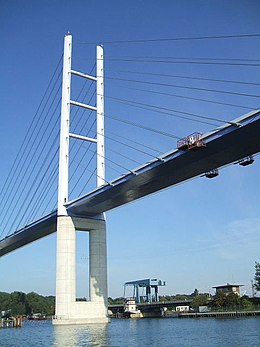This article includes a list of references, related reading, or external links, but its sources remain unclear because it lacks inline citations. (August 2020) |
Rügen Bridge Rügenbrücke | |
|---|---|
 New Rügen Bridge and the old drawbridge | |
| Coordinates | 54°18′30″N 13°06′41″E / 54.30833°N 13.11139°E |
| Carries | |
| Crosses | Strelasund |
| Locale | Stralsund and Rügen Island, Germany |
| Official name | 2. Strelasundquerung |
| Characteristics | |
| Design | cable-stayed bridge |
| Material | Steel pre-stressed concrete |
| Total length | 2,831 metres (9,288 ft) |
| Width | 3 traffic lanes |
| Height | 126 metres (413 ft) |
| Longest span | 198 metres (650 ft) |
| Piers in water | 19 |
| Clearance below | 42 metres (138 ft) |
| History | |
| Designer | André Keipke |
| Construction start | 31 August 2004 |
| Construction end | 20 October 2007 |
| Opened | 22 October 2007 |
| Statistics | |
| Daily traffic | 23,000 |
| Toll | None |
| Location | |
 | |

Strelasund Crossing is the two links to the German island of Rügen (Rugia) over the Strelasund to the West Pomeranian mainland near Stralsund: the Rügen Bridge or Rugia Bridge (German: Rügenbrücke) and the Rugia Causeway (German: Rügendamm).
Ferry services between Stralsund and Altefähr and between Stahlbrode and Glewitz are also available to cross the Strelasund sound.
The Rügendamm was the first fixed crossing over the sound of Strelasund, for both the old Bundesstraße 96, the Stralsund–Sassnitz railway and a combined footpath and cycle path. It was completed 1936/1937.
Rügenbrücke is the name of the three-lane viaduct completed in 2007 exclusively for motor traffic, between the village of Altefähr on Rugia Island and the Hanseatic and world heritage town of Stralsund; as part of the concept to turn the B96 and European route E22 into a ring road. Both bridges are operated in parallel. The Rugia Bridge has an overall length of 2,831 metres (9,288 ft), which makes it one of Central Europe's largest bridges.